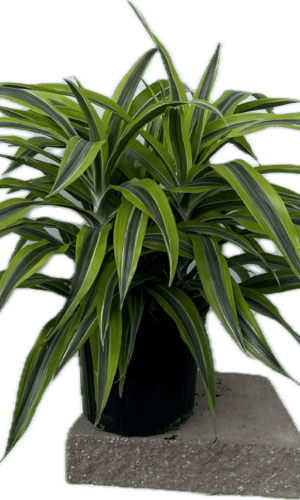
Dracaena warnekii, like all dracaenas, are hardy, slow-growing plants that thrive on neglect. Sometimes referred to as a “Lemon Lime”. A dracaena warnekii is one of the few colorful indoor plants that can survive in low light conditions. NASA recommends the dracaena warnekii one of the top ten plants for removing formaldehyde from the air.
A Dracaena warnekii survives in low light, but grows faster and fuller in medium light. In low light, the new leaves may be smaller and narrower. Direct sun burns the leaves.
All dracaena plants like to be kept on the dry side. Water well and then allow the top 50% of the soil to dry out before watering again. Never allow the plant to sit in water. The lower the light level the less water a dracaena warnekii needs. All dracaenas are very sensitive to fluoride. If your household water is heavily chlorinated allow it to sit out over night, use water from an outside hose, use rain water or distilled water.
Usual household temperatures between 65°- 80°F (18.3°-26.7°C). are fine for a Dracaena Warnekii. Keep the leaves of striped dracaenas away from cold windows, air conditioners, and heaters. Dracaena plants prefer high humidity but do well in basic household humidity.
Mealy Bugs and spider mites can sometimes be a problem.
Fluoride toxicity causes brown leaf tips and long tan/brown streaks in the white stripes of the leaves. Over watering causes root rot. Fusarium Leaf Spot Disease causes reddish tan spots with wide, yellow halos on a Dracaena Warnekii.
Use a fast-draining well-aerated loose soil. Dracaena plants can even be grown in soil mixed with lava rock.
These plants like to be root-bound in a small pot. When the roots have filled the existing pot, it is time to move your dracaena warnekii to the next size container. Be sure any pot you use has drip holes in the bottom.
NASA recommends a dracaena warnekii as a clean air plant.


